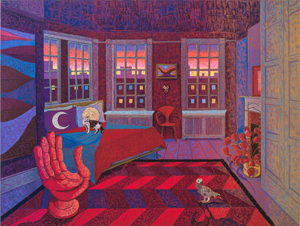1.29.24 — Make Yourself at Home
J. J. Manford combines a dedication to neatness and order with an almost comic excess—of sunlight, color, and art-historical references. It is enough to put a fashionable property owner and follower of fashion to shame, at Derek Eller through February 3.
 Someone like that surely owns the interiors he depicts, at least in his imagination, but could easily run out of space. No wonder, then, that his scene has expanded, a few steps outdoors to survey the property or halfway inside to a greenhouse not for plants but for relaxing in the company of pets and possessions. If that amounts to a transitional space between inside and out, it suits objects that move casually between cultures. It suits, too, objects that may leave you wondering whether to call them posters and replicas or thefts from museums and other collections on behalf of some wealthy customers or the artist himself.
Someone like that surely owns the interiors he depicts, at least in his imagination, but could easily run out of space. No wonder, then, that his scene has expanded, a few steps outdoors to survey the property or halfway inside to a greenhouse not for plants but for relaxing in the company of pets and possessions. If that amounts to a transitional space between inside and out, it suits objects that move casually between cultures. It suits, too, objects that may leave you wondering whether to call them posters and replicas or thefts from museums and other collections on behalf of some wealthy customers or the artist himself.
As ever, Manford works in a mix of oil stick, oil pastel, and Flashe, the vinyl-based paint, for tactile surfaces and clashing colors. Paintings within paintings let in the imagined sky, while glimpses outside could just as easily be works of art. Sculpture within a painting includes a colorful African god or warrior that has marched onto a coffee table where a proper collectible could hardly belong. As for the figurine on the sofa behind it, it could be part of a matched set or an intruder in disguise, but it owes just as much to Disney as to the Third World. Is this a sneak attack on the class that buys work like Manford’s or a wish to have it all? Is it a model or a parody of “intersectionality”? I leave the rest of the story to my review from his last show, in 2001, and to an excerpt following here.
As I wrote then, Manford’s painting can change before your eyes from obsessive order to an unholy mess. These are interiors, from people with a sense of propriety and exquisite taste. They would never let ornamentation stand in the way of clean lines and New England wood. They would never overfurnish or leave a dirty dish on the table. Nor would they intrude on a painting like his, not at the risk of upstaging the decor. Even their pets sit or stand on alert.
From there, things do not so much fall apart as burst wide open. In another artist, such alignments could flatten the living quarters into formalism or the decorative arts, calling attention to their cleverness along the way. Manford is not so much punning on life and art as allowing their full colors to show. Abstract paintings within his paintings throb with the light and color of the setting sun. The view out the window becomes a painting in itself. If his compositions grow claustrophobic, one can feel the claustrophobia in the pit of one’s stomach and right between the eyes.
The interior’s collectibles become hard to recognize amid the overflow, but this is not a quiz. He is just admiring how much art can encompass and sharing his own tastes. They are eclectic tastes at that—and more than real-life inhabitants could likely afford. Feel equally drawn to Max Ernst between Surrealism and abstraction, Niki de Saint Phalle with her sexually charged childishness, Mose Toliver with his African American folk art, and Elizabeth Murray with painting flying off the wall? Ready to throw in a vase in the shape of a toucan, a rug with phases of the sun and moon, and a Tibetan tapestry? Make yourself at home.
Home has some other unlikely guests as well. A baby giraffe, poised beneath a painting by Alexander Calder, looks out upon a sun deck, lush grass, a dark mountain, and the throbbing sun. A stegosaurus the size of a puppy, a giant red hand, and a parrot claim the floor. They are just sculpture, right? No doubt, but then the stairs glow with a deep red that must be only natural, too, unless it is not. Paint itself can feel like a murder weapon or startling intruder. As Manford drags his brush across burlap, it brings out a stretch of blue, burning like fresh blue blood.
How can the wood of a chair have deep blue underpainting? Paint’s sheer intensity matters more here than illusion. It could almost be bleeding out from within. Manford works on linen as well as a coarser ground, in oil stick, oil pastel, and Flashe, a still novel rubber-based paint, for their color and raw texture. You may have your reservations about the melodrama of crowded surfaces. Still, animals and abstraction here are equally fierce, in the space of the interior and in its art.
Read more, now in a feature-length article on this site.